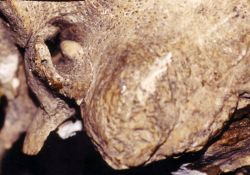
Individuals among prehistoric people often engaged in intense water-related activities, such as diving, surfing and fishing can now be identified, as determining their daily activities has ever been difficult without written records.
Scientists have discovered a new method to make such detailed studies of individual activities of prehistoric people. Scientists have spotted that abnormal ear canal bone masses — called auditory exostoses — can be linked to aquatic activities!
Sabine Eggers, who worked on the study with Celia Boyadjian and Maria Okumura explained,
Auditory exostoses can develop when the ear is exposed to cold water (below around 66.2 degrees Fahrenheit) and/or to warmer water chilled by the action of cold atmospheric temperature and/or strong winds.
Eggers is a researcher at the University of Sao Paulo, Brazil’s Biological Anthropology Laboratory in the Department of Genetics and Evolutionary Biology. He said,
external region of the ear canal responds to chill with increased blood flow and inflammation.
The tissues in the bones produces new cells and this — over time — can lead to bony outgrowths that may extend help for making scientific study, but can lead to hearing loss in the subject.
Other such clues hint at what the coastal dwellers did both above and under water.
Picture: Cecilia Petronilho

